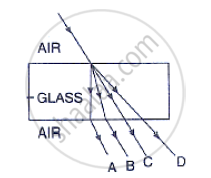Advertisements
Advertisements
Question
A ray of light travelling in water emerges into air. Draw a ray-diagram indicating the change in its path.
Solution

When a ray of light travelling in water enters air, it bends away from the normal.
RELATED QUESTIONS
Draw a labelled ray diagram to show how a ray of light passes through a parallel sided glass block:
if it hits the glass block at 90° (that is, perpendicular to the glass block)
A convex lens of focal length 8 cm forms a real image of the same size as the object. The distance between object and its image will be:
(a) 8 cm
(b) 16 cm
(c) 24 cm
(d) 32 cm
Which part causes the greatest convergence?
In figure , name the ray which represents the correct path of light while emerging out through
a glass block.

For which position of the object does a convex lens form a virtual and erect image? Explain with the help of a ray diagram.

i. Which type of microscope has the arrangement of lenses shown in the adjoining figure?
ii. Label the figure correctly.
iii. Write the working of this microscope.
iv. Where does this microscope used?
v. Suggest a way to increase the efficiency of this microscope.
A concave mirror and convex lens are held in water. What changes, if any, do you expect in their focal length?

The above image shows a thin lens with a focal length of 5m.
- What is the kind of lens shown in the above figure?
- If a real inverted image is to be formed by this lens at a distance of 7m from the optical centre, then show with calculation where should the object be placed.
- Draw a neatly labelled diagram of the image formation mentioned in (ii).
Distinguish between:
Concave lens and Convex Lens
Distinguish between:
Concave lens and Convex Lens
